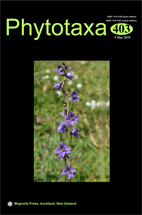Abstract
Verruconis heveae, a new species accommodated in Sympoventuriaceae was isolated from dried latex on bark of a rubber tree (Hevea brasiliensis) collected from Phayao Province, Thailand. The comparison of its morphological characters distinguished V. heveae from other Verruconis species by having brown, woolly mycelium on the natural substrate and solitary, ellipsoidal to subglobose, 1–3 septate conidia. Phylogenetic analysis of a combined LSU and ITS dataset revealed a distinct lineage within Sympoventuriaceae.

